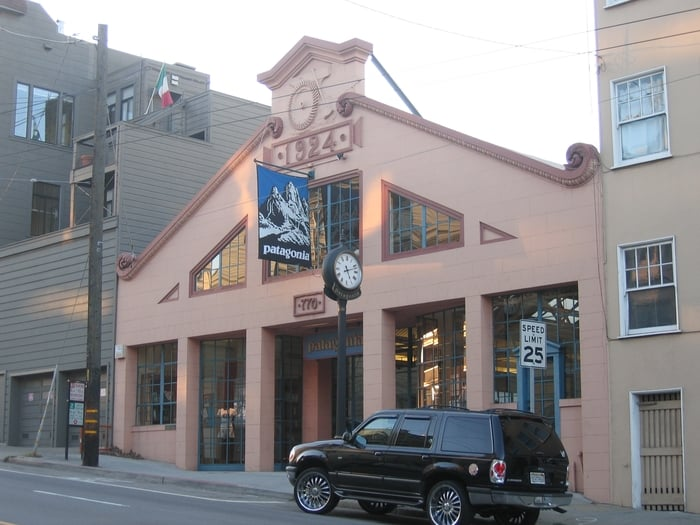
Last week, an official government account attacked outdoor-apparel company Patagonia on Twitter. The U.S. House Committee on Natural Resources (@NatResources) tweeted an image saying that the popular outdoor-apparel company just wants to sell “more products to wealthy elitist urban dwellers from New York to San Francisco.” The tweet was a response to Patagonia suing the government for its slashes to two Utah national monuments, a move the retailer made in conjunction with a broad social media push, claiming, “The President stole your land.”
The tweet:
I was proud of Patagonia’s stance, but the @NatResources tweet struck a nerve. I own a Patagonia puffer, but I wouldn’t consider myself “elitist.”
I purchased my own Patagonia puffy jacket — one of my first purchases from the brand — because it looked warm, had good reviews and was on sale. All my (San Francisco) friends had puffy jackets too. Putting those pieces together, I found the purchase to be totally logical. I’ve since worn it on hikes, commutes, airplanes and ski trips, more than making up for its maybe-pricey-but-mostly-reasonable purchase price during its years in my possession.
When you’re walking around San Francisco or Palo Alto, you’ll notice that Patagonia-style puffy jackets are a cold-weather staple. Everyone is wearing one. If it weren’t a trend, you might wonder if it is the official uniform here.
Since I bought my Patagonia jacket, I’ve also traveled quite a bit around California and the nation, and I’ve realized something: when you’re walking around San Francisco or Palo Alto, you’ll notice that Patagonia-style puffy jackets are a cold-weather staple. Everyone is wearing one. If it weren’t a trend, you might wonder if it is the official uniform here. That’s not the case when you leave the Bay Area, though. Folks in Modesto don’t wear them. Neither do dwellers in rural Modoc County, in our state’s northeastern corner.(On a recent bike-touring trip, our Bay Area–based entourage’s puffy-jacket propensity was distinctly out of place among the plaid and camo patterns favored by area residents.) They’re a rare sight in Texas, New York City and in Washington, DC, too — at least in my travels.
There’s logical reason for that, though. In southerly states, the winters are generally more mild (although a good fleece zip-up can still come in handy). And in the northeast, a puffy jacket may not even qualify as the bare minimum during “real” winters and snowstorms. There you’ve got some serious winter-coat variety: parkas, fur, trenchcoats.
Unfortunately for me, it’s pretty universally acknowledged that Patagonia is considered elitist.
“Oh yeah, Patagonia is definitely elitist,” my fiancé said when I talked to him about my quandary. “But you have a puffy jacket that looks exactly the same as mine,” I countered. It’s not like Patagonia emblazons its logo across all of its gear like a Coach handbag. Without glancing at the tag, it’s impossible to tell if it’s actually Patagonia or if it’s Marmot, Arc’teryx or another outdoor brand, unless you’re intimately familiar with each brand’s specific quilting patterns. On top of that, the pricing among these companies is really very comparable. Patagonia has somehow become the poster child for all these outdoor-apparel makers—and in particular, the poster child of “elitist” Left Coasters.
Calling liberals and West Coasters elitist has been a ploy of the Republican Party and Tea Party since before the Obama days, but as this 2010 Slate article explains, elitism is in the eye of the beholder. Who and what qualifies as elitist depends on who’s doing the talking (or tweeting). To the rest of the country, with its billion-dollar acquisitions, sky-high real estate market and plurality of “brogrammers” and “disruptepreneurs” innovating at the expense of industries in their hometowns, the Bay Area is the epitome of an elitist society — and the Patagonia brand has become synonymous with that image, due to the techie-bro predilection for wearing it.
With that in mind, I understand why Patagonia is labeled as elitist. But it’s also sad—Patagonia prides itself on its environmental best practices and takes both its corporate and social responsibility seriously. The company’s mission statement is to “[b]uild the best product, cause no unnecessary harm, use business to inspire, and implement solutions to the environmental crisis,” and it donates “at least” 1 percent of its sales to grassroots environmental organizations. (Litigating against the cuts to Utah’s monuments will surely prove even more costly.) It’s disappointing that we’ve come to a point where a brand founded on sustainability is having to fight our government.
This fight also feels intensely hypocritical on the part of the Republican powers that be. The Republican ideology is predicated on unfettered capitalism as well as the success of American corporations at the expense of their workforce and the environment. They continue to strip workforce protections, yet they somehow assume companies are going to act in the best interests of people. Patagonia has shown that it knows how to profit in a capitalist world without abusing its workforce or the environment. (And in the rare case when unethical treatment was discovered, swift action was taken to right the wrong.) With its tweet against Patagonia, the House Committee on Natural Resources is committing a sort of double whammy: railing on a successful US company for being successful and also railing against one that actually cares about the usage of the country’s land and natural resources.
Still, even given its reputation, I don’t think my Patagonia jacket is elitist. I think it’s practical and comfy, to boot. If @NatResources really wanted to talk about elitist winter wear, perhaps it should have singled out Ivy League sweatshirts or the ubiquitous start-up hoody. And perhaps the Natural Resources committee “squad” should ditch their blazers and see what it’s like to don a Patagonia jacket of their own. They might just find that the company’s ethics aren’t so distasteful when you’re actually enjoying the outdoors.







